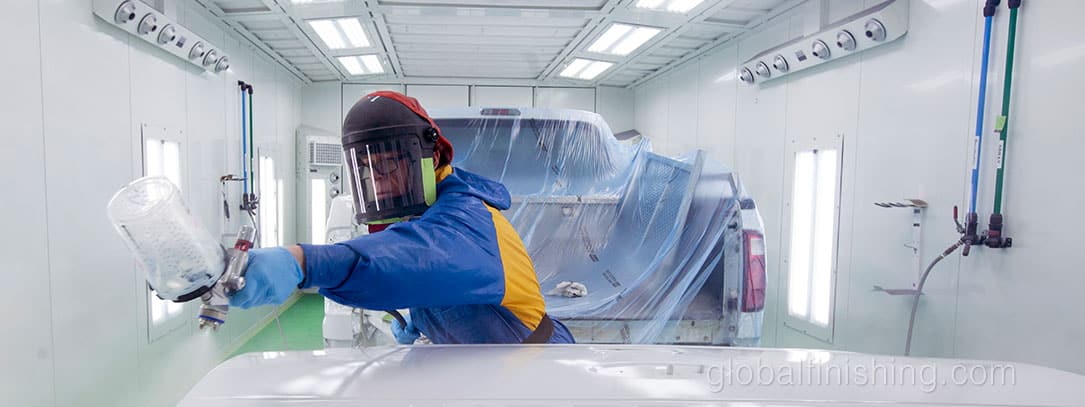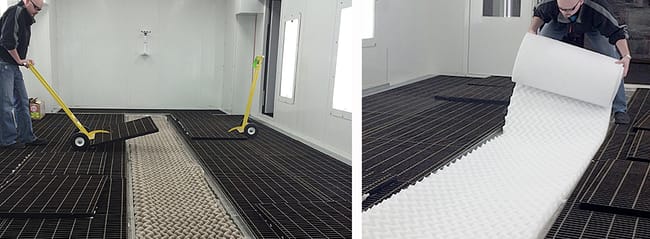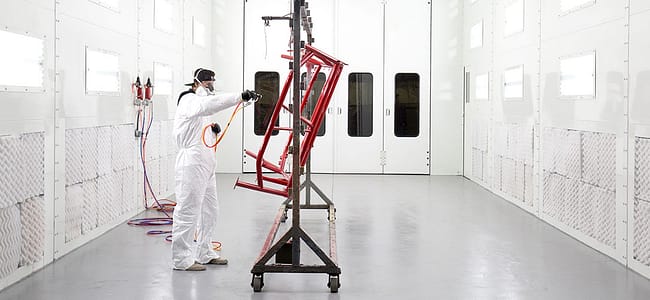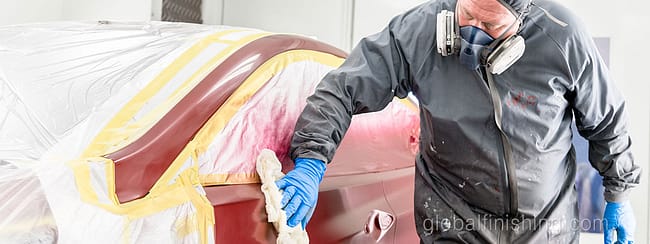
Paint booths are designed to confine hazardous materials to a controlled environment and prevent flammable or combustible overspray from causing a fire or explosion.
However, hazards can still exist within a paint booth, and a variety of personal protective equipment (PPE) can be used to keep painters safe and help prevent health problems. Knowing how to mitigate those hazards and which type of PPE is appropriate for tasks are the keys to running a safe finishing operation.
As many common primers, paints and cleaning materials used in finishing operations are classified as flammable or combustible liquids, national codes have been established to reduce the risk of fire and explosion in the spray booth. These codes include the International Fire Code (IFC), National Fire Code of Canada (NFC) and NFPA 33 (Standard for Spray Application Using Flammable or Combustible Materials).
“I help ensure a safe working environment for our customers, and we design our paint booths to meet the applicable requirements of the codes or standards,” said Geoff Raifsnider, senior mechanical engineer for Global Finishing Solutions (GFS).
Per these codes and standards, a spray booth must meet the following requirements:

Fire risks in paint booths can also be reduced by ensuring spray areas are kept free of excessive accumulation of overspray, routinely changing exhaust filters and practicing proper filter disposal. Code requires that spray and exhaust areas shall be protected by an automatic fire protection system. Sprinkler heads and dry chemical nozzles within the spray area should be protected from overspray by covering them with thin paper or cellulose-based materials. This includes those located in exhaust plenums and exhaust ducts.
Some spray booths can operate at up to 200 degrees Fahrenheit during cure cycles. When curing at elevated temperatures, chemicals released in the paint booth may be hazardous to your health.
To protect workers from chemical exposure and the elevated temperature, a door interlock switch — standard on all GFS enclosed pressurized paint booths — deters entry into the booth during cure mode. If a paint booth door is opened during cure mode, the booth automatically switches out of cure mode, and the temperature in the booth reverts to the temperature set during spray mode. As an added safety measure, the lights on GFS paint booths automatically turn off when the booth is switched to cure mode, so technicians know not to enter the booth.
Work platforms and personnel lifts are commonly used in spray booths to allow painters to spray hard-to-reach areas. These items are designed to meet the standards of OSHA 1910.68 and ANSI A92, which may include requirements for a handrail encompassing the platform, a self-latching gate and a safety harness attachment point. The minimum height for providing fall protection in the U.S. is 4 feet, and in Canada, it is 3 meters.
Recent changes to OSHA requirements mandate that employers have a ladder safety or personal fall arrest system for fixed ladders that extend more than 24 feet from a lower level and phases out the use of cages and wells for fall protection. The code does not require the removal of existing cages if their presence does not interfere with the use of a ladder safety or personal fall arrest system. Since GFS cannot guarantee that a cage will not interfere, our standard ladder is one without a cage.

To avoid exposure to isocyanates, technicians should always wear a full-body paint suit when spraying. Isocyanate compounds are a dangerous chemical found in most paints and varnishes that can irritate your skin or cause breathing issues when inhaled. Low levels of exposure to isocyanates can lead to hives and rashes, whereas high levels can result in chest pains and breathing problems.
“Your body absorbs isocyanates from the paint materials, and that stuff builds up in your system until you actually become allergic,” said Jason Garfoot, senior technical advisor for GFS. “For a lot of painters, that ends their career.”
Disposable suits may be worn for about a week. They are made of thinner material and can easily tear, so be cautious, especially when kneeling on exhaust pit grating. Non-disposable painter’s suits typically last for months, as they are made of thicker material. Painters should wash their non-disposable suit once a week in a washing machine by itself, using basic detergent without fabric softener.

Nitrile gloves are recommended when spraying and mixing paint to protect against isocyanate sensitization. They weigh about the same as latex gloves, enabling painters to get a good feel for the paint gun.
It is a myth that gloves are not needed when spraying waterborne paint.
“There are less solvents in waterborne paint, but there are still a lot of substances that are harmful to the human body found in paint,” Garfoot said.
Half-mask respirators are ideal for priming but are not recommended for large paint jobs because of the amount of overspray that could end up on your face. Their lifespan is usually less than a month. When not in use, they must be stored in the packaging and sealed.
“If you leave the mask in your mix room or on the shop floor just hanging up and exposed to the open air, the next day, you might as well throw it away because you would have likely used up the exposure limits,” Garfoot said.
Breathable fresh air systems are “your safest and best option,” according to Garfoot. That is because they provide clean, outdoor air, including a three-stage filtration system, with separate lines solely for breathable air. They are now more comfortable to wear, as belts have gotten smaller and are more lightweight, and can even house a built-in air conditioning unit. A carbon monoxide meter should also be worn by the painter or installed in the fresh air system.
Using a code-compliant paint booth not only is necessary to meet local, state and national safety codes but also to protect your workers, your facility and the environment. Before installing new equipment, make sure to contact your local Authority Having Jurisdiction (AHJ) to determine what codes and standards are enforced in your area.
The use of PPE is essential to keep painters safe on the job, in addition to helping them avoid short- and long-term health risks. For PPE to be most effective, determine what PPE is best for your operation and ensure you are using the appropriate type.
One of the best ways to highlight your business is through a story that you can share across your online platforms. It humanizes your business and shows that your business can make a meaningful impact. Your testimonial would be used as a project profile on the GFS Booth Blog and can be shared on your website and/or social media channels.
Complete this form and we’ll be in touch to showcase your company.

Shop a variety of GFS aftermarket products, including booth protection products and mobile accelerated curing units. And enjoy the convenience of fast and free ground shipping throughout the contiguous United States.

Located at GFS’ headquarters in Osseo, Wisconsin, the Center for Excellence is an innovative facility featuring an automotive refinish training center, as well as a separate space dedicated to technical product training.

GFS is continuously searching for talented, ambitious individuals to join our team. We aim to provide our employees with every opportunity to make an impact on the company and find their niche along the way — weather in a production, field services or an office position.